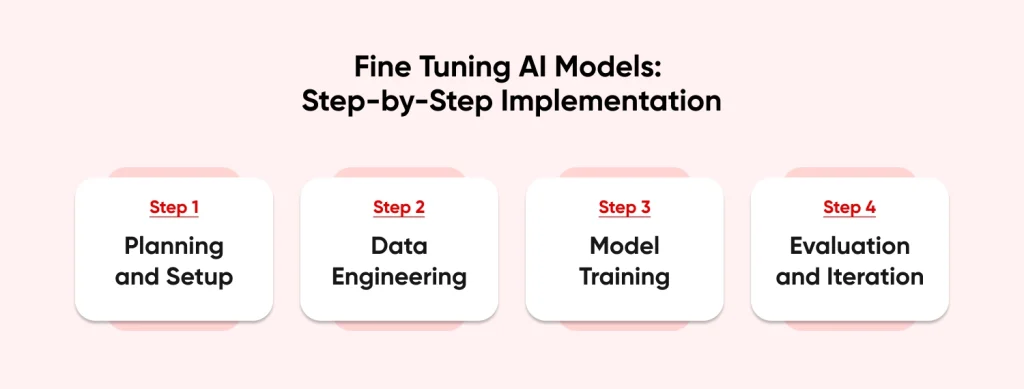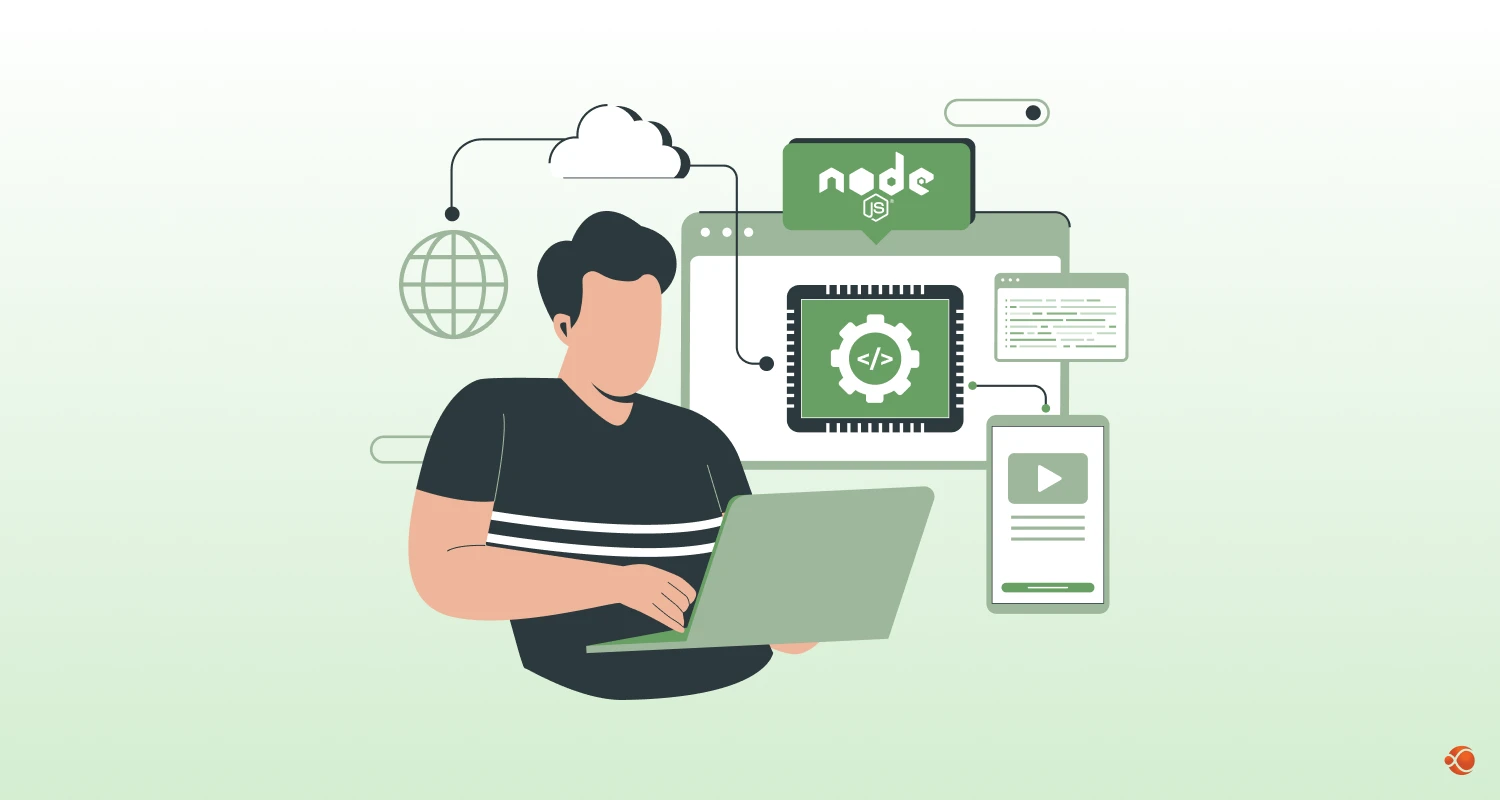Generic AI models are like Swiss Army knives – useful for many tasks but not perfect for any specific job. That’s where AI model fine-tuning comes in. It transforms general-purpose models into specialized tools that excel at your exact business needs.
Fine-tuning takes a pre-trained model and adapts it using your specific data. Think of it as teaching an experienced chef your family’s secret recipes. The chef already knows cooking basics, but now they can make your grandmother’s apple pie exactly right.
This approach has revolutionized how businesses implement AI solutions. Instead of building models from scratch, companies can now customize existing powerful models for their unique challenges.
Understanding AI Model Fine-Tuning in Today’s Market
Market Growth and Performance Benefits
The demand for AI fine-tuning is rising fast as more businesses identify the advantages it offers. By tailoring pre-trained models to handle specific tasks, companies can achieve more precise results and improved performance. This kind of customization is becoming an essential way for organizations to stand out and stay ahead in a competitive market.
Speed and Efficiency Advantages
Traditional AI development used to take months or years. Fine-tuning reduces this timeline significantly. This speed advantage is driving rapid adoption across industries.
The process works by taking a model’s learned patterns and adjusting them for specific tasks. It’s like teaching a multilingual person a new dialect – they already understand language structure, they just need to learn the local variations.
How AI Model Fine-Tuning Works: The Technical Foundation
The Core Process
Fine-tuning begins with a pre-trained foundation model—these are models that have already learned broad patterns from large-scale datasets. Common examples include GPT, BERT, and other models designed for specific industries.
The next step is preparing a domain-specific dataset that reflects the real-world scenarios your AI will be handling. It’s not just about having a lot of data—what really counts is the relevance and quality of that data. The better your dataset matches your target use case, the more effective your fine-tuned model will be.
python
# Loading a pre-trained model for fine-tuning
from transformers import AutoModel, AutoTokenizer
model = AutoModel.from_pretrained("gpt-3.5-turbo")
tokenizer = AutoTokenizer.from_pretrained("gpt-3.5-turbo")Transfer Learning and Model Adaptation
Next is the actual fine-tuning phase, where the model’s internal parameters, often called “weights” are adjusted using your specific dataset. You can think of this like fine-tuning a precision instrument: the model already knows the basics, but now it’s being calibrated to perform accurately within your unique context. This step helps the AI better understand and respond to the exact scenarios it will face in your application.
Transfer learning in AI makes this possible by leveraging the knowledge acquired during pre-training, adapting it to specific tasks with reduced computation time and resources. This approach saves enormous amounts of time and computational resources compared to training from scratch.
Standard Implementation Workflow
Most fine-tuning projects follow a similar pattern. You start with data preparation, move to model selection, then training and validation. Each step requires careful attention to prevent overfitting or data leakage.
Real-World AI Applications: Where Fine-Tuning Shines
Healthcare and Medical Diagnosis
Medical AI requires extreme precision. Generic models can’t handle specialized medical terminology or rare conditions. Fine-tuning language models on medical literature creates AI that understands complex diagnoses.
Hospitals are using fine-tuned models for radiology reports, patient intake, and treatment recommendations. These systems learn from years of medical records to make accurate assessments.
Healthcare organizations report improved diagnosis times and reduced errors when implementing fine-tuned AI systems tailored to their specific medical specialties and patient populations.
Financial Services and Risk Assessment
Banks need AI that understands financial regulations and market nuances. Fine-tuning and implementing trained AI models on financial data creates systems that can assess credit risk, detect fraud, and ensure compliance.
These models learn from transaction patterns, regulatory documents, and market data. They become experts in financial language and decision-making processes.
Investment firms and banks are using fine-tuned models to improve market prediction accuracy and risk assessment capabilities, leading to better investment decisions and reduced financial exposure.
Customer Service Automation
AI for Customer Service requires understanding your specific products, policies, and customer language. Generic chatbots often frustrate customers with irrelevant responses.
Fine-tuned customer service models learn from your support tickets, product manuals, and FAQ databases. They understand your company’s tone and can handle complex customer scenarios.
Companies implementing fine-tuned customer service AI report fewer escalations to human agents and improved customer satisfaction scores compared to generic chatbot solutions.
Custom AI Development: Building Your Fine-Tuning Strategy
Data Collection and Preparation
Success with fine-tuning starts with high-quality data. Your dataset should closely reflect the real-world situations where the AI will be used—including edge cases and tricky examples that push the model to its limits.
Equally important is data cleaning. That means removing duplicates, fixing formatting issues, and making sure labels are consistent throughout. Even the best fine-tuning process can’t make up for messy or inaccurate data—garbage in, garbage out still applies.
python
# Basic data preparation for fine-tuning
training_data = [ {"input": "Customer complaint about billing", "output": "Forward to billing department"}, {"input": "Technical support request", "output": "Create support ticket"}
]Consider data privacy and compliance early. Healthcare and financial data require special handling. Work with legal teams to ensure your data collection meets all regulations.
Choosing the Right Base Model
Not all foundation models work equally well for every task. Text generation tasks benefit from GPT-style models, while classification tasks might work better with BERT-based approaches.
Consider model size and computational requirements. Larger models perform better but cost more to run. Balance performance needs with operational constraints.
Look for models pre-trained on relevant domains. A model trained on scientific literature will fine-tune better for research applications than one trained on general web content.
Training and Validation Process
Split your data carefully. Use 70% for training, 15% for validation, and 15% for final testing. This ensures your model generalizes well to new data.
Monitor training closely. Watch for overfitting signs like improving training accuracy but declining validation performance. Early stopping prevents this common issue.
Test thoroughly before deployment. Use real-world scenarios and edge cases. Have domain experts evaluate the model’s outputs for accuracy and appropriateness.
Fine Tuning AI Models: Step-by-Step Implementation

Phase 1: Planning and Setup
Start by defining clear metrics before starting the AI fine-tuning model implementation process. Ask questions such as:
- What are the improvements you are looking for?
- How will you measure the success of your AI fine-tuning models?
- Who will I need for my project?
Phase 2: Data Engineering
Clean and format your training data consistently. Inconsistent formatting confuses models and reduces performance. Automated tools can help, but manual review is often necessary.
Create balanced datasets when possible. If you’re fine-tuning for classification, ensure each category has sufficient examples. Imbalanced data leads to biased models.
python
# Setting up training configuration
training_config = { "learning_rate": 2e-5, "batch_size": 16, "epochs": 3, "warmup_steps": 100
}Document your data preprocessing steps. You’ll need to apply the same transformations to new data during production use. Clear documentation prevents costly mistakes.
Phase 3: Model Training
Start with conservative training parameters. High learning rates can destroy the pre-trained model’s useful patterns. Gradually increase intensity if needed.
Use techniques like learning rate scheduling and gradient clipping. These prevent training instability and help models converge to better solutions.
Experiment with different fine-tuning approaches. Full fine-tuning adjusts all model parameters, while methods like LoRA only modify specific layers. Each approach has trade-offs.
Phase 4: Evaluation and Iteration
Test on held-out data that the model has never seen. This provides honest performance estimates. Training data performance can be misleadingly optimistic.
Compare against baselines. How does your fine-tuned model perform versus the original model or simpler alternatives? The improvement should justify the effort.
Gather feedback from end users. Technical metrics don’t always reflect real-world usefulness. User feedback reveals practical issues that metrics might miss.
AI Model Fine-Tuning Services: Build vs. Buy Decisions
When to Build Train AI Model In-House
It makes sense to build train AI models for companies with unique data or specialized requirements. If your use case is core to your business advantage, internal development provides better control.
You’ll need significant technical expertise. The investment in talent and infrastructure can be substantial.
Consider long-term maintenance costs. Models need regular updates as data patterns change. In-house teams can respond quickly to these needs but require ongoing investment.
When to Partner with AI Development Services
Artificial intelligence development services offer expertise without the overhead. They bring experience across multiple industries and can avoid common pitfalls that slow internal teams.
Look for providers with relevant industry experience. AI for healthcare requires different expertise than AI for financial services. Domain knowledge significantly impacts project success.
Evaluate their development processes. Good providers follow rigorous testing and validation procedures. They should explain their quality assurance methods clearly.
Hybrid Approaches
Many successful projects combine internal domain knowledge with external technical expertise. Your team provides business context while partners handle technical implementation.
This approach accelerates development while building internal capabilities. Your team learns from experienced practitioners while maintaining control over strategic decisions.
Building and Training AI Models: Technical Considerations

Infrastructure Requirements
Fine-tuning requires significant computational resources. GPU clusters are essential for training large models efficiently. Cloud providers offer flexible options without large upfront investments.
Storage needs can be substantial. Training datasets, model checkpoints, and experiment logs consume considerable space. Plan for data management from the beginning.
Monitoring tools help track training progress and resource usage. These tools identify problems early and optimize resource allocation. Good monitoring saves time and money.
Model Architecture Decisions
Choose architectures that match your problem type. Transformer models excel at language tasks, while convolutional networks work better for images. Architecture choice significantly impacts performance.
Consider model size carefully. Larger models often perform better but require more resources. Balance performance needs with operational constraints.
Experiment with hybrid architectures when appropriate. Combining different model types can provide benefits that single architectures miss. This requires more expertise but can yield superior results.
Deployment Considerations
Plan deployment infrastructure early. Real-time applications need low latency, while batch processing can tolerate higher delays. Infrastructure requirements vary dramatically between use cases.
Consider model serving frameworks. Tools like TensorFlow Serving or Torch Serve simplify deployment and scaling. Choose frameworks that provide seamless integration with your existing systems.
Plan for model updates. Fine-tuned models may need regular retraining as data patterns evolve. Design systems that support seamless model updates without service interruption.
Hiring AI Developers: Building Your Fine-Tuning Team
Essential Skills and Expertise
It is very important to hire ai developers with practical experience in fine-tuning AI models. Basic machine learning knowledge will limit the level of customization and specific-problem solving ability. It is also important that the developer has proper expertise about the domain of the client. Each industry has its requirements, limitations and compliance requirements that can affect the overall project’s architecture significantly.
Domain knowledge is crucial. Developers should understand your industry’s specific requirements and constraints. This knowledge guides better architectural decisions and training strategies.
Practical experience with deployment matters. Many developers can train models but struggle with production deployment. Look for end-to-end experience from development to production.
Team Structure and Roles
Data scientists design experiments and analyze results. They determine training strategies and interpret model performance. Strong statistical backgrounds are essential.
ML engineers handle infrastructure and deployment. They build training pipelines and production systems. Software engineering skills are as important as ML knowledge.
Domain experts provide business context and validate results. They ensure models solve real problems effectively. Their feedback guides model improvements and deployment decisions.
Evaluating Technical Competence
Ask candidates about specific fine-tuning projects. Look for detailed discussions of challenges faced and solutions implemented. Generic answers suggest limited practical experience.
Review code samples and architectural decisions. Good developers can explain their choices clearly and discuss trade-offs made. Technical depth matters for complex projects.
Consider cultural fit. Fine-tuning projects require close collaboration between technical and business teams.
Technical Skills for a Fine-Tune AI model developer:
- Strong ML fundamentals (supervised, unsupervised, reinforcement learning)
- Expertise in TensorFlow, PyTorch, or JAX
- Knowledge of NLP and transformer models (BERT, GPT)
- Data preprocessing, cleaning, and augmentation
- Fine-tuning techniques and hyperparameter tuning
- Proficient in Python and ML libraries (NumPy, Pandas, Scikit-learn)
- Experience with ML automation and pipelines
- Familiarity with cloud ML platforms (AWS SageMaker, Google AI Platform, Azure ML)
- Version control with Git and GitHub/GitLabs
- Containerization (Docker) and Kubernetes (optional)
- Model evaluation, validation, and monitoring
- API development and integration for model serving
- Awareness of AI security and ethical practices

Implementing Trained AI Models: From Development to Production
Production Readiness Checklist for AI Fine-Tuning Models
Test thoroughly under realistic conditions. Laboratory performance doesn’t always translate to production environments. Load testing and edge case evaluation are essential.
Document deployment procedures clearly. Multiple team members should be able to deploy and maintain the system. Clear documentation prevents single points of failure.
Plan rollback procedures. New models sometimes perform worse than expected. Having quick rollback capabilities prevents prolonged service disruptions.
Monitoring and Maintenance
Monitor model performance continuously. Real-world data often differs from training data, causing performance degradation over time. Early detection prevents user impact.
Track business metrics alongside technical metrics. Technical performance doesn’t always correlate with business value. Monitor both to ensure continued success.
Plan regular model updates. Data patterns evolve, requiring periodic retraining. Establish update schedules based on performance monitoring and business needs.
Scaling Considerations
Design for scale from the beginning. Successful AI applications often experience rapid growth in usage. Infrastructure should handle increased demand gracefully.
Consider geographic distribution. Global applications may need regional deployments for performance and compliance reasons. Plan for multi-region architecture early.
Optimize for cost efficiency. Cloud costs can grow quickly with AI applications. Regular optimization reviews help control expenses while maintaining performance.
The AI Ecosystem Models: Choosing the Right Foundation
Popular Foundation Models
Choosing the right AI ecosystem models for the right purpose can help streamline and fast-track AI implementation significantly.
GPT models excel at text generation and conversation. They work well for content creation, customer service, and creative applications. Recent versions offer impressive capabilities across many domains.
BERT-based models perform better for text classification and analysis tasks. They understand context well and work effectively for document processing and sentiment analysis.
Specialized models exist for specific domains. Scientific models understand research literature better than general models. Choose foundations that match your application domain.
Model Selection Criteria
Consider task requirements carefully. Generation tasks need different architectures than classification tasks. Match model capabilities to your specific needs.
Evaluate computational requirements. Larger models perform better but cost more to run. Balance performance needs with operational constraints and budget limitations.
Review licensing terms. Some models have restrictions on commercial use. Ensure your chosen model supports your intended application and business model.
Future-Proofing Your Choice
Choose models with active development communities. Regular updates and improvements extend model useful life. Abandoned models quickly become obsolete.
Consider migration paths between model versions. API compatibility and training procedures should remain stable across updates. Frequent breaking changes increase maintenance costs.
Evaluate vendor lock-in risks. Some models tie you to specific platforms or services. Consider the long-term implications of these dependencies on your business flexibility.
AI PoC Development Services: Validating Your Fine-Tuning Strategy
Look for companies that provide through and through ai poc development services that covers all aspects such as:
Proof of Concept Planning
Define success criteria clearly before starting. What specific outcomes will demonstrate value? Clear metrics guide development and provide objective evaluation criteria.
Limit scope to essential features. PoCs should demonstrate core value quickly. Additional features can be added after proving basic viability.
Choose representative test data carefully. PoC data should reflect real-world scenarios accurately. Poor test data leads to misleading results and poor decisions.
Rapid Prototyping Approaches
Use existing tools and frameworks when possible. Building everything from scratch slows PoC development unnecessarily. Focus effort on proving core concepts.
Consider cloud-based development environments. They provide necessary resources without infrastructure investment. This accelerates development and reduces initial costs.
Plan for iterative development. PoCs often require multiple iterations to achieve desired results. Build flexibility into timelines and resource planning.
Measuring PoC Success
Compare results against current solutions. Incremental improvements may not justify implementation costs. Look for significant performance gains that provide clear business value.
Gather stakeholder feedback early and often. Technical success doesn’t guarantee business adoption. Regular feedback ensures PoCs address real business needs.
Document lessons learned thoroughly. PoC insights guide full implementation planning. Good documentation prevents repeating mistakes and accelerates development.
Why Choose CMARIX for AI Model Fine-Tuning Services?
CMARIX is leading the way of AI revolution with multiple service and focus areas in AI software development services. Our dedicated AI model fine-tuning development services deliver real business results to our clients. We have dedicated AI developers that understand the importance and best practices of fine-tuning across different industries and applications.
Key advantages of partnering with CMARIX:
- End-to-end expertise – From data preparation to production deployment, we handle all aspects of your AI model fine-tuning project
- Industry-specific knowledge – Our developers have successfully fine-tuned models for healthcare, finance, e-commerce, and manufacturing sectors
- Rapid development cycles – Proven methodologies and pre-built frameworks result in faster project completion.
Conclusion
AI model fine-tuning transforms generic models into specialized business tools. Success requires quality data, appropriate expertise, and clear objectives. Whether building internally or partnering with development services, focus on measurable outcomes and iterative improvement for lasting AI success.
FAQs on AI Model Fine-Tuning
What Is AI Model Fine-Tuning and Why Is It Important?
AI model fine-tuning involves taking a pre-trained model and further training it on specific, task-focused data to adapt it for particular use cases. It’s important because it allows you to leverage the general knowledge of large models while customizing them for specialized domains, achieving better performance than using generic models or training from scratch.
How Does Fine-Tuning Improve the Accuracy of AI Models?
Fine-tuning makes AI models more accurate by training them on examples from a specific field or task. This helps the model pick up on the kind of language, patterns, and details that might not show up much in general training data. It also teaches the model how to respond in a particular style or format and to better understand the context of specialized topics—so the results are more relevant, useful, and precise.
What Are Some Real-World Use Cases Where Fine-Tuning Significantly Improves AI Performance?
Medical diagnosis systems fine-tuned on clinical data achieve higher accuracy in identifying conditions and suggesting treatments. Legal document analysis benefits from fine-tuning on case law and contracts for better clause identification and risk assessment. Customer service chatbots perform significantly better when fine-tuned on company-specific FAQs, policies, and historical support conversations.
Can I Fine-Tune Openai’s GPT Models?
Yes, OpenAI offers fine-tuning for models like GPT-3.5 Turbo and GPT-4 through their API. You can upload your training data in the required format, initiate the fine-tuning process through their platform, and create custom versions tailored to your specific needs and use cases.
What Tools and Platforms Can Help With Fine-Tuning?
Popular platforms include Hugging Face Transformers for open-source models, Google’s Vertex AI for cloud-based fine-tuning, and AWS SageMaker for enterprise solutions. OpenAI’s API provides fine-tuning for their models, while frameworks like PyTorch and TensorFlow offer lower-level control for custom implementations.







